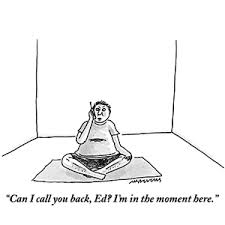Week 2

Keeping the body in mind
‘If we’re not careful, it is all too easy to fall into becoming more of a human doing than a human being, and forget who is doing all the doing, and why.’ Jon Kabat Zinn
Practicing the Body Scan in week 1 revealed the characteristic of Doing and Being mode:
Qualities of “Doing” Mode
- Goal-oriented efforts to “fix” things
- Increasingly harder efforts towards reaching goals
- Most actions tend to happen automatically
- Lack of conscious awareness in the present moment
Qualities of “Being” Mode
Awareness how things "are" and not how they "should" be.
- Connection with the present moment
- Acknowledgement of how things are in the moment
- Willingness to allow things to be just as they are… no efforts to alter/change experience
- Openness and acceptance of pleasant, neutral, and negative emotional states
- Calmness, stillness, and a sense of being centered
Although the ‘doing mode’ can be useful in many areas of our lives, it is not so great for dealing with emotional distress. By trying to get rid of the emotions we don’t want our thoughts go around and around, while we are getting nowhere in our attempts to feel better. We will keep feeling this general ‘sense of lack’.
In the ‘doing mode’ you focus on the gap of what you want and what there actually is which is exactly what makes us feel miserable. By switching to the ‘being mode’ we are able to get out of our rumination and unhelpful thought patterns. We stop over identifying with our thoughts and being stuck in them. We get back to being present in the here and now and accept what is without judging it.
A mindful life is not just about stopping to pause from time to time, grounding ourselves for a few moments in the here and now – although those times are certainly valuable. Mindfulness is about bringing a sense of ‘being’ into all the ‘doing’ aspects of our lives, regardless of whether life is relaxed or hectic right now. So rather than rushing through our tasks half-heartedly, caught up in thoughts about something completely different, we commit to being fully present with whatever we’re doing, whether it’s writing an email, washing the dishes, or crawling along in a traffic jam on the way to an important appointment. Whatever it is, we bring our full attention to the task – we become fully embodied within it.
"No problem can be solved from the same level of consciousness that created it." Albert Einstein
Now, more than ever, we (the world) needs mindfulness. "Our lives are now driven by the ever-quickening expectations that we place on ourselves and that others place on us and we on them. These expectations are generated in a large measure by our increasing dependence on ubiquitous digital technology and its ever-accelerating effects on our pace of life," according to Kabat-Zinn.
Tasting Mindfulness by Jon Kabat-Zinn
Have you ever had the experience of stopping so completely,
of being in your body so completely,
of being in your life so completely,
that what you knew and what you didn’t know,
that what had been and what was yet to come,
and the way things are right now
no longer held even the slightest hint of anxiety or discord?
It would be a moment of complete presence, beyond striving, beyond mere
acceptance,
beyond the desire to escape or fix anything or plunge ahead,
a moment of pure being, no longer in time,
a moment of pure seeing, pure feeling,
a moment in which life simply is,
and that “is-ness” grabs you by all your senses,
all your memories, by your very genes,
by your loves, and
welcomes you home,
this is a taste of mindfulness.
The Formal practice for this week is Mindfulness movement. Altering the relationship with the bodies can profoundly improve our lives.
To cultivate mindfulness truly,
we need to become fully integrated with
with our body once more.
Practice for week 2
- Practice Mindful movement ( Meditation 3) followed by 10 min sitting observing body sensations and breath. Do Mindful yoga (links below) at least once during the week. Or feel free to find any other yoga practices on Youtube and carry them out mindfully.
- If you have an excisiting exercise routine, slow it down and see if can you be more present in the body and with the sensations.
- Go for a walk or use walking from A to B as a mindfulness exercise – be aware of all the senses – smells, sights, sounds, touch and of your thoughts.
- Become aware when you are checking your mobile phone tenth time in an hour and filling every minute of your day by some form of tech distraction.
- Continue carrying out a simple everyday activity mindfully and notice when you are on automatic pilot or just daydreaming.
- Fill in Pleasant Events Calendar
Related practises:
Podcast with Johann Hari
Related articles:http://www.psychologytoday.com/blog/the-mindful-self-express/201204/learning-be-present-yourself
Technology v human an Article in Forbes magazine
Video All it takes is 10 mindful minutes by Andy Puddicombe

